Consumer Behavior Report: Online Piracy and Marketing Strategies
VerifiedAdded on 2022/11/26
|9
|2621
|308
Report
AI Summary
This report examines the challenges posed by online piracy to the online entertainment and content industry, focusing on the behavior of consumers aged 20-35 who seek gripping content. It identifies the core issue as the impact of piracy on subscription revenue and business viability, and investigates the motivations behind consumer behavior, particularly the influence of cost and convenience. The report employs the self-determination theory to analyze internal motivations, such as autonomy and competence, and recommends three marketing strategies: market penetration pricing to increase affordability, relationship marketing to gain customer feedback, and benefit-based marketing to highlight the advantages of original content. The report concludes by emphasizing the importance of enhancing value propositions to combat piracy and protect the industry's financial health.

Running head: CONSUMER BEHAVIOR
Consumer behavior
Name of the student
Name of the university
Author note
Consumer behavior
Name of the student
Name of the university
Author note
Paraphrase This Document
Need a fresh take? Get an instant paraphrase of this document with our AI Paraphraser
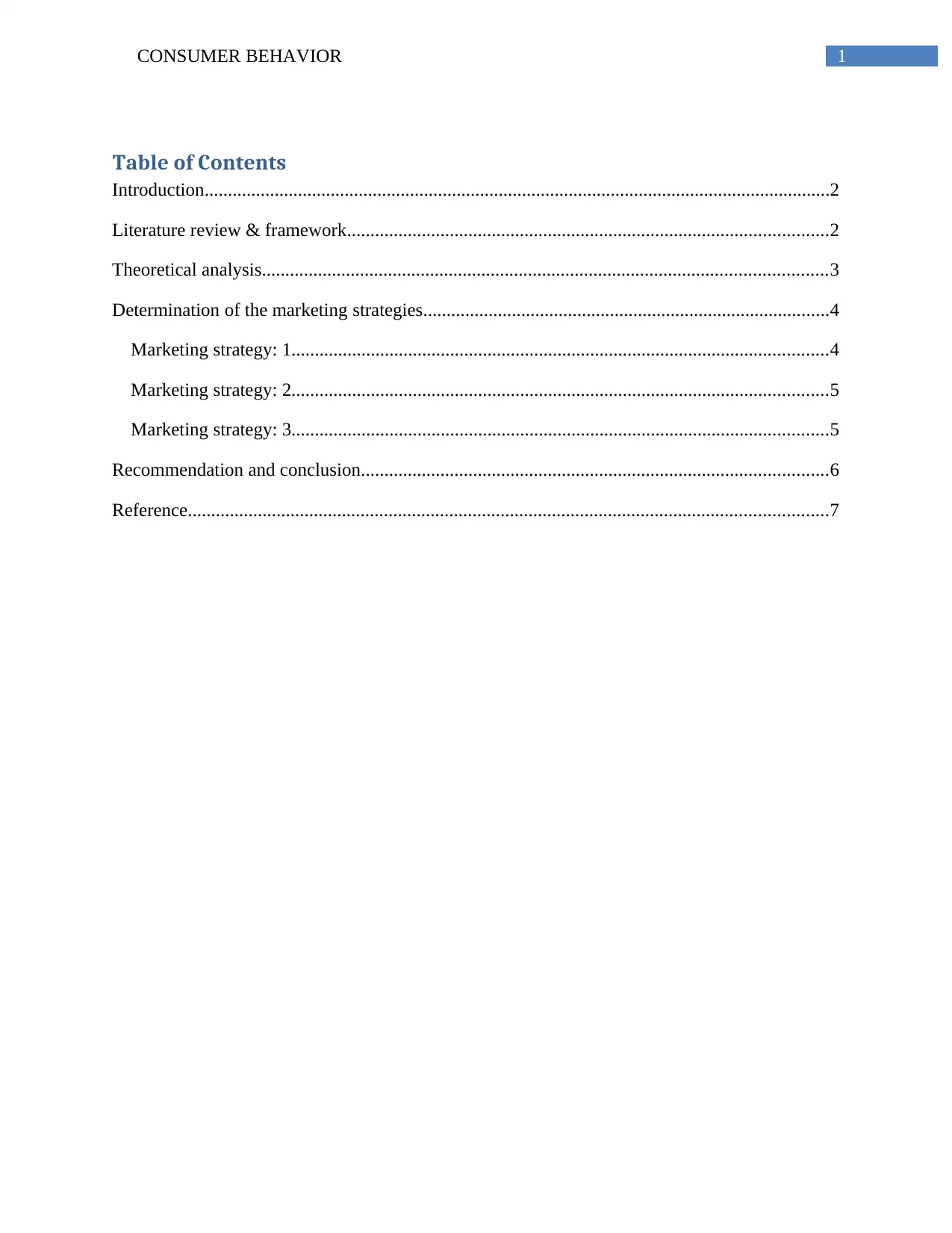
1CONSUMER BEHAVIOR
Table of Contents
Introduction......................................................................................................................................2
Literature review & framework.......................................................................................................2
Theoretical analysis.........................................................................................................................3
Determination of the marketing strategies.......................................................................................4
Marketing strategy: 1...................................................................................................................4
Marketing strategy: 2...................................................................................................................5
Marketing strategy: 3...................................................................................................................5
Recommendation and conclusion....................................................................................................6
Reference.........................................................................................................................................7
Table of Contents
Introduction......................................................................................................................................2
Literature review & framework.......................................................................................................2
Theoretical analysis.........................................................................................................................3
Determination of the marketing strategies.......................................................................................4
Marketing strategy: 1...................................................................................................................4
Marketing strategy: 2...................................................................................................................5
Marketing strategy: 3...................................................................................................................5
Recommendation and conclusion....................................................................................................6
Reference.........................................................................................................................................7
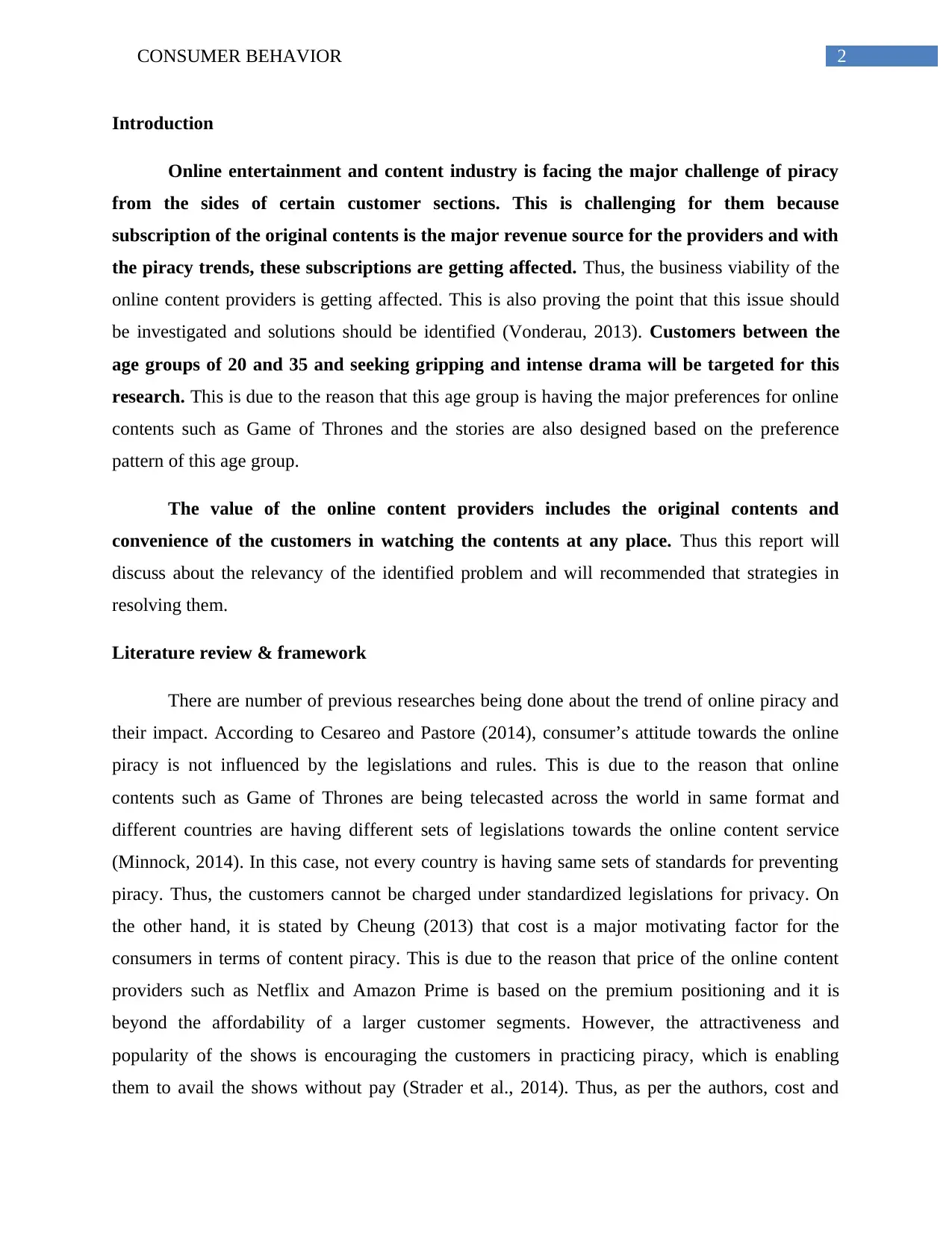
2CONSUMER BEHAVIOR
Introduction
Online entertainment and content industry is facing the major challenge of piracy
from the sides of certain customer sections. This is challenging for them because
subscription of the original contents is the major revenue source for the providers and with
the piracy trends, these subscriptions are getting affected. Thus, the business viability of the
online content providers is getting affected. This is also proving the point that this issue should
be investigated and solutions should be identified (Vonderau, 2013). Customers between the
age groups of 20 and 35 and seeking gripping and intense drama will be targeted for this
research. This is due to the reason that this age group is having the major preferences for online
contents such as Game of Thrones and the stories are also designed based on the preference
pattern of this age group.
The value of the online content providers includes the original contents and
convenience of the customers in watching the contents at any place. Thus this report will
discuss about the relevancy of the identified problem and will recommended that strategies in
resolving them.
Literature review & framework
There are number of previous researches being done about the trend of online piracy and
their impact. According to Cesareo and Pastore (2014), consumer’s attitude towards the online
piracy is not influenced by the legislations and rules. This is due to the reason that online
contents such as Game of Thrones are being telecasted across the world in same format and
different countries are having different sets of legislations towards the online content service
(Minnock, 2014). In this case, not every country is having same sets of standards for preventing
piracy. Thus, the customers cannot be charged under standardized legislations for privacy. On
the other hand, it is stated by Cheung (2013) that cost is a major motivating factor for the
consumers in terms of content piracy. This is due to the reason that price of the online content
providers such as Netflix and Amazon Prime is based on the premium positioning and it is
beyond the affordability of a larger customer segments. However, the attractiveness and
popularity of the shows is encouraging the customers in practicing piracy, which is enabling
them to avail the shows without pay (Strader et al., 2014). Thus, as per the authors, cost and
Introduction
Online entertainment and content industry is facing the major challenge of piracy
from the sides of certain customer sections. This is challenging for them because
subscription of the original contents is the major revenue source for the providers and with
the piracy trends, these subscriptions are getting affected. Thus, the business viability of the
online content providers is getting affected. This is also proving the point that this issue should
be investigated and solutions should be identified (Vonderau, 2013). Customers between the
age groups of 20 and 35 and seeking gripping and intense drama will be targeted for this
research. This is due to the reason that this age group is having the major preferences for online
contents such as Game of Thrones and the stories are also designed based on the preference
pattern of this age group.
The value of the online content providers includes the original contents and
convenience of the customers in watching the contents at any place. Thus this report will
discuss about the relevancy of the identified problem and will recommended that strategies in
resolving them.
Literature review & framework
There are number of previous researches being done about the trend of online piracy and
their impact. According to Cesareo and Pastore (2014), consumer’s attitude towards the online
piracy is not influenced by the legislations and rules. This is due to the reason that online
contents such as Game of Thrones are being telecasted across the world in same format and
different countries are having different sets of legislations towards the online content service
(Minnock, 2014). In this case, not every country is having same sets of standards for preventing
piracy. Thus, the customers cannot be charged under standardized legislations for privacy. On
the other hand, it is stated by Cheung (2013) that cost is a major motivating factor for the
consumers in terms of content piracy. This is due to the reason that price of the online content
providers such as Netflix and Amazon Prime is based on the premium positioning and it is
beyond the affordability of a larger customer segments. However, the attractiveness and
popularity of the shows is encouraging the customers in practicing piracy, which is enabling
them to avail the shows without pay (Strader et al., 2014). Thus, as per the authors, cost and
⊘ This is a preview!⊘
Do you want full access?
Subscribe today to unlock all pages.

Trusted by 1+ million students worldwide
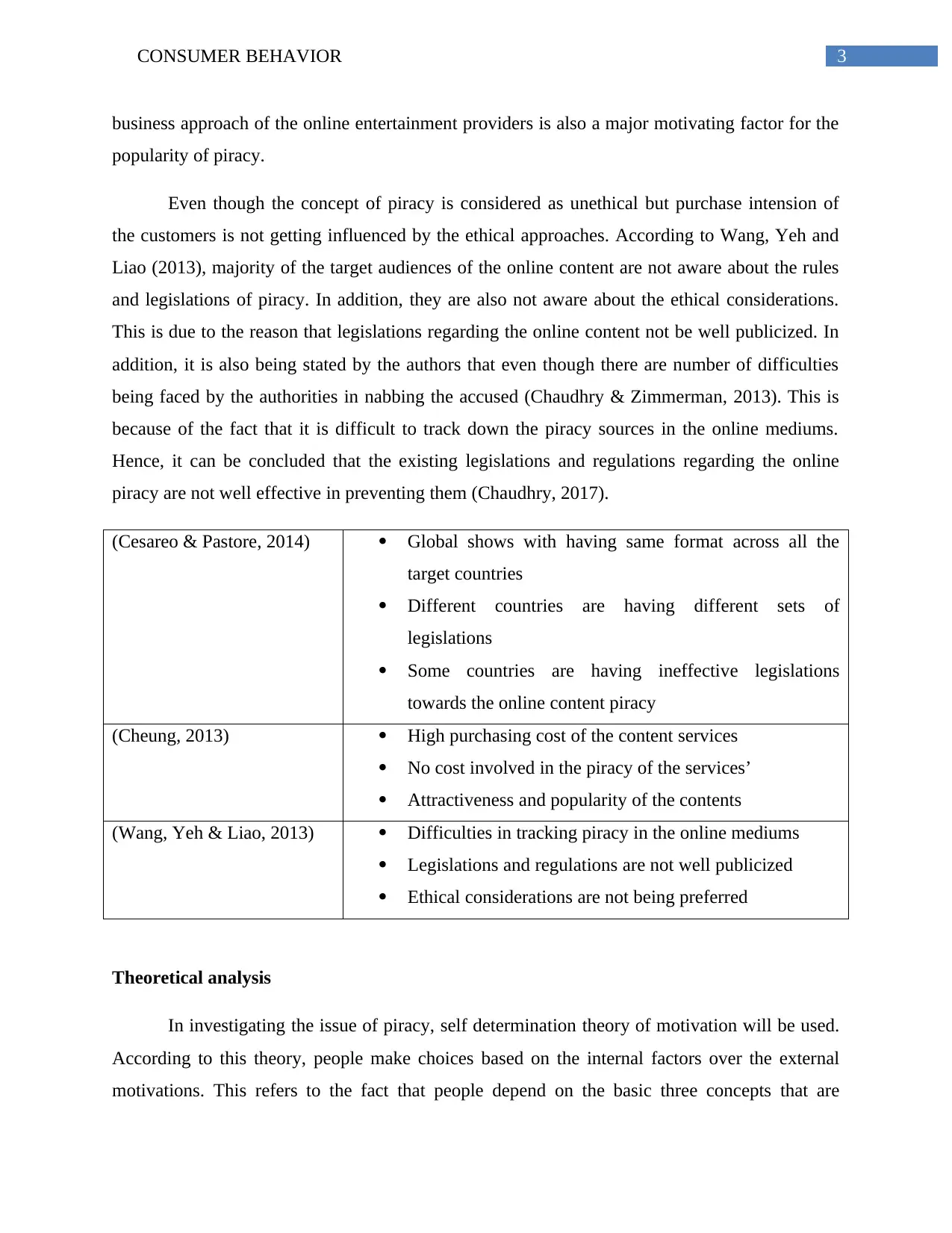
3CONSUMER BEHAVIOR
business approach of the online entertainment providers is also a major motivating factor for the
popularity of piracy.
Even though the concept of piracy is considered as unethical but purchase intension of
the customers is not getting influenced by the ethical approaches. According to Wang, Yeh and
Liao (2013), majority of the target audiences of the online content are not aware about the rules
and legislations of piracy. In addition, they are also not aware about the ethical considerations.
This is due to the reason that legislations regarding the online content not be well publicized. In
addition, it is also being stated by the authors that even though there are number of difficulties
being faced by the authorities in nabbing the accused (Chaudhry & Zimmerman, 2013). This is
because of the fact that it is difficult to track down the piracy sources in the online mediums.
Hence, it can be concluded that the existing legislations and regulations regarding the online
piracy are not well effective in preventing them (Chaudhry, 2017).
(Cesareo & Pastore, 2014) Global shows with having same format across all the
target countries
Different countries are having different sets of
legislations
Some countries are having ineffective legislations
towards the online content piracy
(Cheung, 2013) High purchasing cost of the content services
No cost involved in the piracy of the services’
Attractiveness and popularity of the contents
(Wang, Yeh & Liao, 2013) Difficulties in tracking piracy in the online mediums
Legislations and regulations are not well publicized
Ethical considerations are not being preferred
Theoretical analysis
In investigating the issue of piracy, self determination theory of motivation will be used.
According to this theory, people make choices based on the internal factors over the external
motivations. This refers to the fact that people depend on the basic three concepts that are
business approach of the online entertainment providers is also a major motivating factor for the
popularity of piracy.
Even though the concept of piracy is considered as unethical but purchase intension of
the customers is not getting influenced by the ethical approaches. According to Wang, Yeh and
Liao (2013), majority of the target audiences of the online content are not aware about the rules
and legislations of piracy. In addition, they are also not aware about the ethical considerations.
This is due to the reason that legislations regarding the online content not be well publicized. In
addition, it is also being stated by the authors that even though there are number of difficulties
being faced by the authorities in nabbing the accused (Chaudhry & Zimmerman, 2013). This is
because of the fact that it is difficult to track down the piracy sources in the online mediums.
Hence, it can be concluded that the existing legislations and regulations regarding the online
piracy are not well effective in preventing them (Chaudhry, 2017).
(Cesareo & Pastore, 2014) Global shows with having same format across all the
target countries
Different countries are having different sets of
legislations
Some countries are having ineffective legislations
towards the online content piracy
(Cheung, 2013) High purchasing cost of the content services
No cost involved in the piracy of the services’
Attractiveness and popularity of the contents
(Wang, Yeh & Liao, 2013) Difficulties in tracking piracy in the online mediums
Legislations and regulations are not well publicized
Ethical considerations are not being preferred
Theoretical analysis
In investigating the issue of piracy, self determination theory of motivation will be used.
According to this theory, people make choices based on the internal factors over the external
motivations. This refers to the fact that people depend on the basic three concepts that are
Paraphrase This Document
Need a fresh take? Get an instant paraphrase of this document with our AI Paraphraser
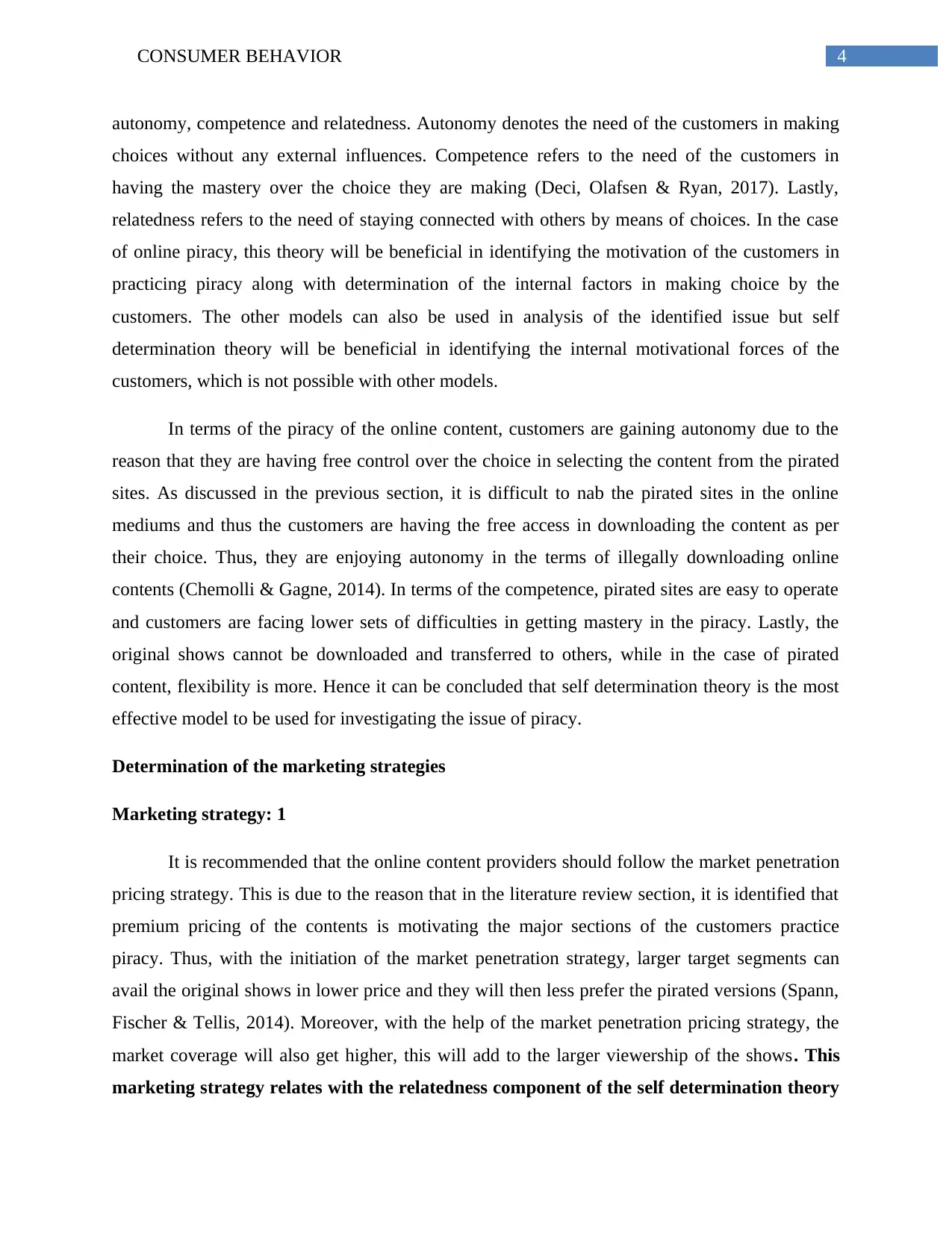
4CONSUMER BEHAVIOR
autonomy, competence and relatedness. Autonomy denotes the need of the customers in making
choices without any external influences. Competence refers to the need of the customers in
having the mastery over the choice they are making (Deci, Olafsen & Ryan, 2017). Lastly,
relatedness refers to the need of staying connected with others by means of choices. In the case
of online piracy, this theory will be beneficial in identifying the motivation of the customers in
practicing piracy along with determination of the internal factors in making choice by the
customers. The other models can also be used in analysis of the identified issue but self
determination theory will be beneficial in identifying the internal motivational forces of the
customers, which is not possible with other models.
In terms of the piracy of the online content, customers are gaining autonomy due to the
reason that they are having free control over the choice in selecting the content from the pirated
sites. As discussed in the previous section, it is difficult to nab the pirated sites in the online
mediums and thus the customers are having the free access in downloading the content as per
their choice. Thus, they are enjoying autonomy in the terms of illegally downloading online
contents (Chemolli & Gagne, 2014). In terms of the competence, pirated sites are easy to operate
and customers are facing lower sets of difficulties in getting mastery in the piracy. Lastly, the
original shows cannot be downloaded and transferred to others, while in the case of pirated
content, flexibility is more. Hence it can be concluded that self determination theory is the most
effective model to be used for investigating the issue of piracy.
Determination of the marketing strategies
Marketing strategy: 1
It is recommended that the online content providers should follow the market penetration
pricing strategy. This is due to the reason that in the literature review section, it is identified that
premium pricing of the contents is motivating the major sections of the customers practice
piracy. Thus, with the initiation of the market penetration strategy, larger target segments can
avail the original shows in lower price and they will then less prefer the pirated versions (Spann,
Fischer & Tellis, 2014). Moreover, with the help of the market penetration pricing strategy, the
market coverage will also get higher, this will add to the larger viewership of the shows. This
marketing strategy relates with the relatedness component of the self determination theory
autonomy, competence and relatedness. Autonomy denotes the need of the customers in making
choices without any external influences. Competence refers to the need of the customers in
having the mastery over the choice they are making (Deci, Olafsen & Ryan, 2017). Lastly,
relatedness refers to the need of staying connected with others by means of choices. In the case
of online piracy, this theory will be beneficial in identifying the motivation of the customers in
practicing piracy along with determination of the internal factors in making choice by the
customers. The other models can also be used in analysis of the identified issue but self
determination theory will be beneficial in identifying the internal motivational forces of the
customers, which is not possible with other models.
In terms of the piracy of the online content, customers are gaining autonomy due to the
reason that they are having free control over the choice in selecting the content from the pirated
sites. As discussed in the previous section, it is difficult to nab the pirated sites in the online
mediums and thus the customers are having the free access in downloading the content as per
their choice. Thus, they are enjoying autonomy in the terms of illegally downloading online
contents (Chemolli & Gagne, 2014). In terms of the competence, pirated sites are easy to operate
and customers are facing lower sets of difficulties in getting mastery in the piracy. Lastly, the
original shows cannot be downloaded and transferred to others, while in the case of pirated
content, flexibility is more. Hence it can be concluded that self determination theory is the most
effective model to be used for investigating the issue of piracy.
Determination of the marketing strategies
Marketing strategy: 1
It is recommended that the online content providers should follow the market penetration
pricing strategy. This is due to the reason that in the literature review section, it is identified that
premium pricing of the contents is motivating the major sections of the customers practice
piracy. Thus, with the initiation of the market penetration strategy, larger target segments can
avail the original shows in lower price and they will then less prefer the pirated versions (Spann,
Fischer & Tellis, 2014). Moreover, with the help of the market penetration pricing strategy, the
market coverage will also get higher, this will add to the larger viewership of the shows. This
marketing strategy relates with the relatedness component of the self determination theory
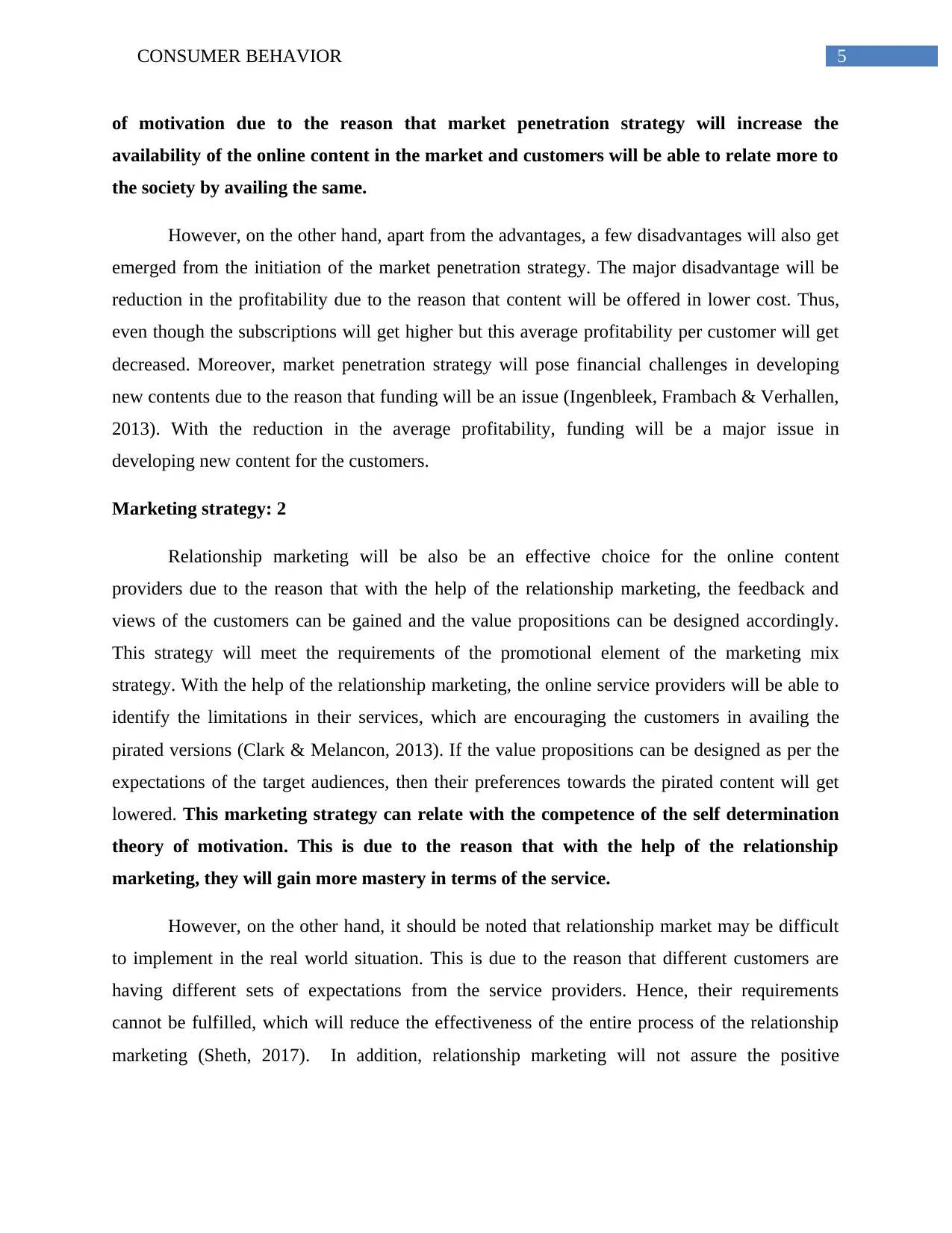
5CONSUMER BEHAVIOR
of motivation due to the reason that market penetration strategy will increase the
availability of the online content in the market and customers will be able to relate more to
the society by availing the same.
However, on the other hand, apart from the advantages, a few disadvantages will also get
emerged from the initiation of the market penetration strategy. The major disadvantage will be
reduction in the profitability due to the reason that content will be offered in lower cost. Thus,
even though the subscriptions will get higher but this average profitability per customer will get
decreased. Moreover, market penetration strategy will pose financial challenges in developing
new contents due to the reason that funding will be an issue (Ingenbleek, Frambach & Verhallen,
2013). With the reduction in the average profitability, funding will be a major issue in
developing new content for the customers.
Marketing strategy: 2
Relationship marketing will be also be an effective choice for the online content
providers due to the reason that with the help of the relationship marketing, the feedback and
views of the customers can be gained and the value propositions can be designed accordingly.
This strategy will meet the requirements of the promotional element of the marketing mix
strategy. With the help of the relationship marketing, the online service providers will be able to
identify the limitations in their services, which are encouraging the customers in availing the
pirated versions (Clark & Melancon, 2013). If the value propositions can be designed as per the
expectations of the target audiences, then their preferences towards the pirated content will get
lowered. This marketing strategy can relate with the competence of the self determination
theory of motivation. This is due to the reason that with the help of the relationship
marketing, they will gain more mastery in terms of the service.
However, on the other hand, it should be noted that relationship market may be difficult
to implement in the real world situation. This is due to the reason that different customers are
having different sets of expectations from the service providers. Hence, their requirements
cannot be fulfilled, which will reduce the effectiveness of the entire process of the relationship
marketing (Sheth, 2017). In addition, relationship marketing will not assure the positive
of motivation due to the reason that market penetration strategy will increase the
availability of the online content in the market and customers will be able to relate more to
the society by availing the same.
However, on the other hand, apart from the advantages, a few disadvantages will also get
emerged from the initiation of the market penetration strategy. The major disadvantage will be
reduction in the profitability due to the reason that content will be offered in lower cost. Thus,
even though the subscriptions will get higher but this average profitability per customer will get
decreased. Moreover, market penetration strategy will pose financial challenges in developing
new contents due to the reason that funding will be an issue (Ingenbleek, Frambach & Verhallen,
2013). With the reduction in the average profitability, funding will be a major issue in
developing new content for the customers.
Marketing strategy: 2
Relationship marketing will be also be an effective choice for the online content
providers due to the reason that with the help of the relationship marketing, the feedback and
views of the customers can be gained and the value propositions can be designed accordingly.
This strategy will meet the requirements of the promotional element of the marketing mix
strategy. With the help of the relationship marketing, the online service providers will be able to
identify the limitations in their services, which are encouraging the customers in availing the
pirated versions (Clark & Melancon, 2013). If the value propositions can be designed as per the
expectations of the target audiences, then their preferences towards the pirated content will get
lowered. This marketing strategy can relate with the competence of the self determination
theory of motivation. This is due to the reason that with the help of the relationship
marketing, they will gain more mastery in terms of the service.
However, on the other hand, it should be noted that relationship market may be difficult
to implement in the real world situation. This is due to the reason that different customers are
having different sets of expectations from the service providers. Hence, their requirements
cannot be fulfilled, which will reduce the effectiveness of the entire process of the relationship
marketing (Sheth, 2017). In addition, relationship marketing will not assure the positive
⊘ This is a preview!⊘
Do you want full access?
Subscribe today to unlock all pages.

Trusted by 1+ million students worldwide
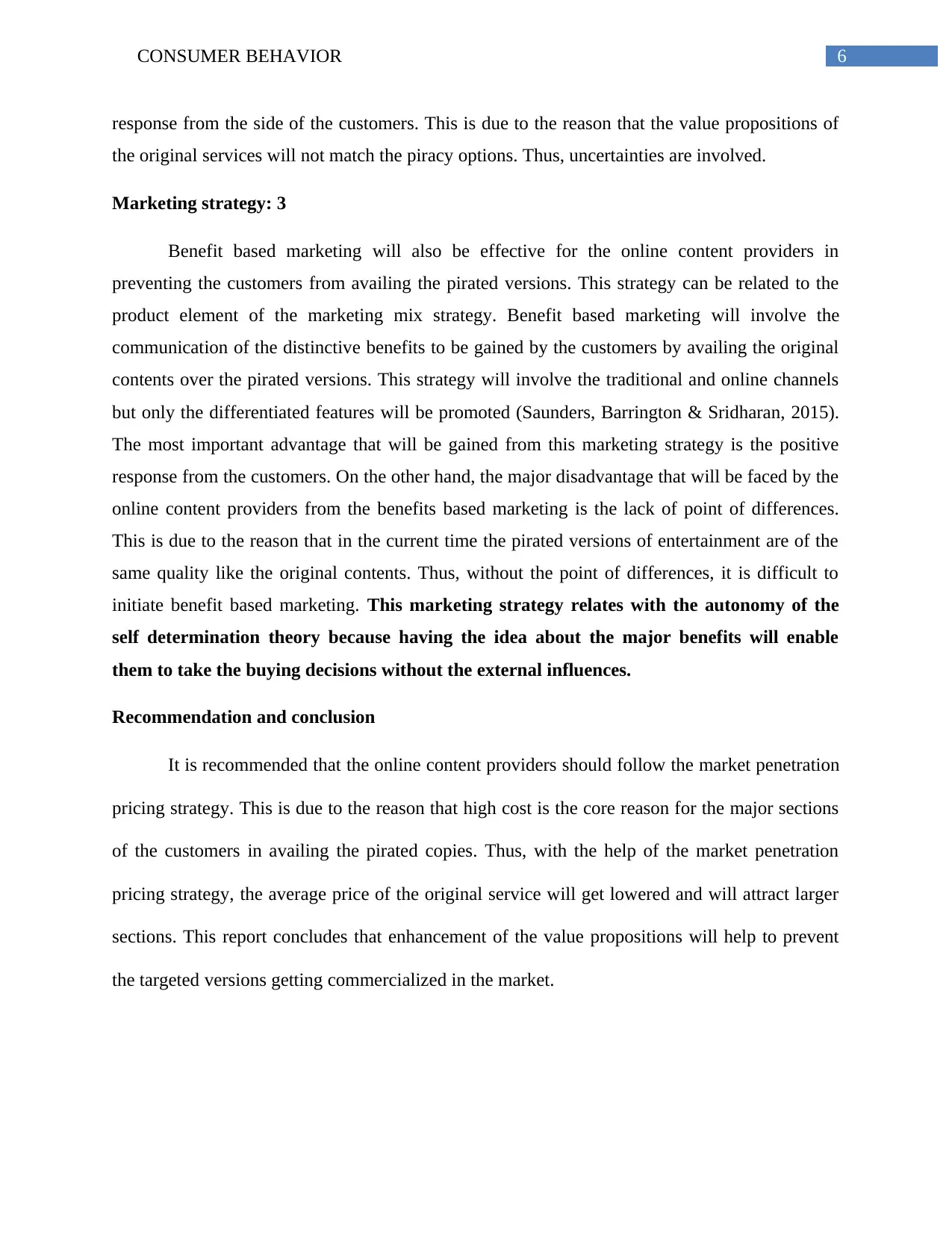
6CONSUMER BEHAVIOR
response from the side of the customers. This is due to the reason that the value propositions of
the original services will not match the piracy options. Thus, uncertainties are involved.
Marketing strategy: 3
Benefit based marketing will also be effective for the online content providers in
preventing the customers from availing the pirated versions. This strategy can be related to the
product element of the marketing mix strategy. Benefit based marketing will involve the
communication of the distinctive benefits to be gained by the customers by availing the original
contents over the pirated versions. This strategy will involve the traditional and online channels
but only the differentiated features will be promoted (Saunders, Barrington & Sridharan, 2015).
The most important advantage that will be gained from this marketing strategy is the positive
response from the customers. On the other hand, the major disadvantage that will be faced by the
online content providers from the benefits based marketing is the lack of point of differences.
This is due to the reason that in the current time the pirated versions of entertainment are of the
same quality like the original contents. Thus, without the point of differences, it is difficult to
initiate benefit based marketing. This marketing strategy relates with the autonomy of the
self determination theory because having the idea about the major benefits will enable
them to take the buying decisions without the external influences.
Recommendation and conclusion
It is recommended that the online content providers should follow the market penetration
pricing strategy. This is due to the reason that high cost is the core reason for the major sections
of the customers in availing the pirated copies. Thus, with the help of the market penetration
pricing strategy, the average price of the original service will get lowered and will attract larger
sections. This report concludes that enhancement of the value propositions will help to prevent
the targeted versions getting commercialized in the market.
response from the side of the customers. This is due to the reason that the value propositions of
the original services will not match the piracy options. Thus, uncertainties are involved.
Marketing strategy: 3
Benefit based marketing will also be effective for the online content providers in
preventing the customers from availing the pirated versions. This strategy can be related to the
product element of the marketing mix strategy. Benefit based marketing will involve the
communication of the distinctive benefits to be gained by the customers by availing the original
contents over the pirated versions. This strategy will involve the traditional and online channels
but only the differentiated features will be promoted (Saunders, Barrington & Sridharan, 2015).
The most important advantage that will be gained from this marketing strategy is the positive
response from the customers. On the other hand, the major disadvantage that will be faced by the
online content providers from the benefits based marketing is the lack of point of differences.
This is due to the reason that in the current time the pirated versions of entertainment are of the
same quality like the original contents. Thus, without the point of differences, it is difficult to
initiate benefit based marketing. This marketing strategy relates with the autonomy of the
self determination theory because having the idea about the major benefits will enable
them to take the buying decisions without the external influences.
Recommendation and conclusion
It is recommended that the online content providers should follow the market penetration
pricing strategy. This is due to the reason that high cost is the core reason for the major sections
of the customers in availing the pirated copies. Thus, with the help of the market penetration
pricing strategy, the average price of the original service will get lowered and will attract larger
sections. This report concludes that enhancement of the value propositions will help to prevent
the targeted versions getting commercialized in the market.
Paraphrase This Document
Need a fresh take? Get an instant paraphrase of this document with our AI Paraphraser
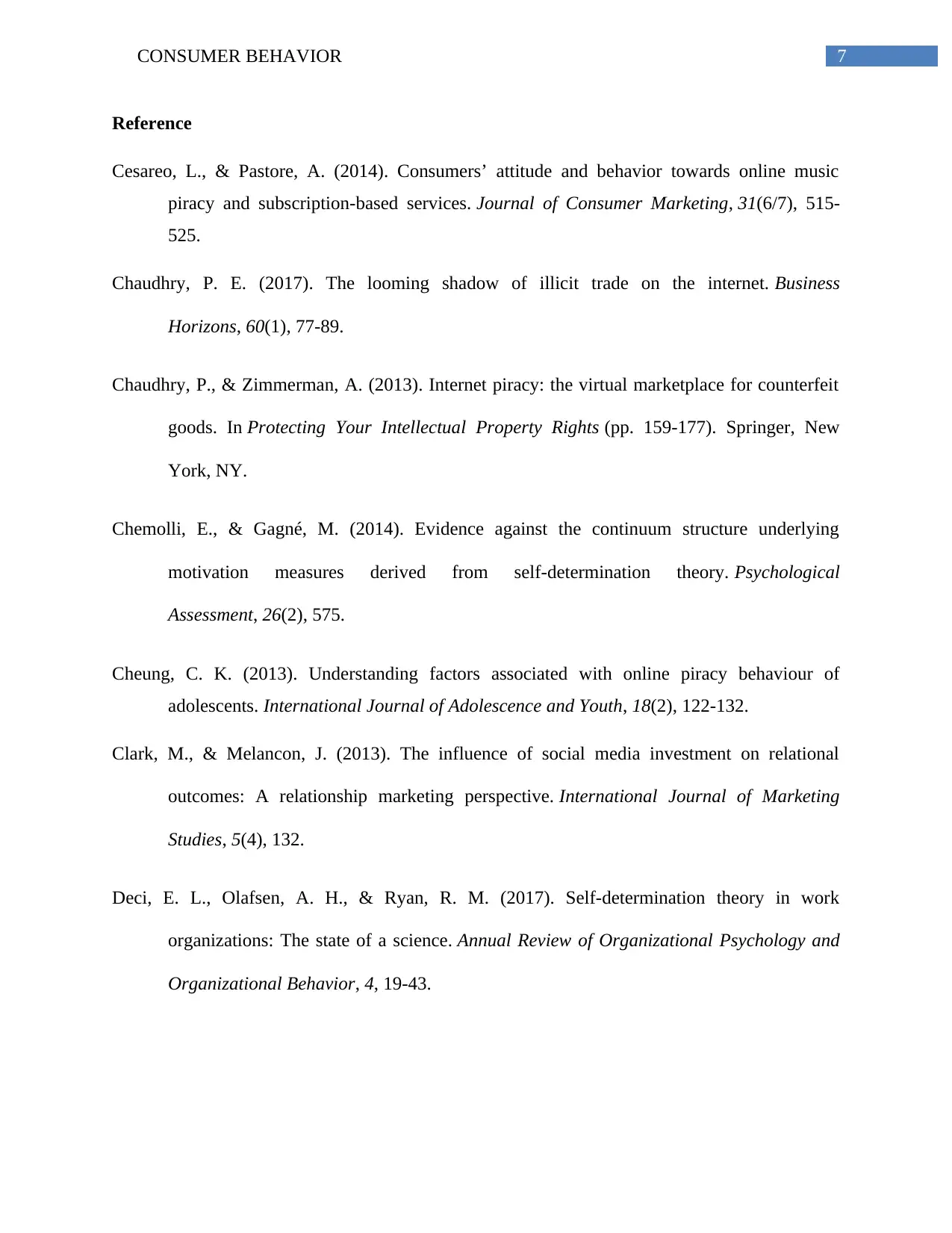
7CONSUMER BEHAVIOR
Reference
Cesareo, L., & Pastore, A. (2014). Consumers’ attitude and behavior towards online music
piracy and subscription-based services. Journal of Consumer Marketing, 31(6/7), 515-
525.
Chaudhry, P. E. (2017). The looming shadow of illicit trade on the internet. Business
Horizons, 60(1), 77-89.
Chaudhry, P., & Zimmerman, A. (2013). Internet piracy: the virtual marketplace for counterfeit
goods. In Protecting Your Intellectual Property Rights (pp. 159-177). Springer, New
York, NY.
Chemolli, E., & Gagné, M. (2014). Evidence against the continuum structure underlying
motivation measures derived from self-determination theory. Psychological
Assessment, 26(2), 575.
Cheung, C. K. (2013). Understanding factors associated with online piracy behaviour of
adolescents. International Journal of Adolescence and Youth, 18(2), 122-132.
Clark, M., & Melancon, J. (2013). The influence of social media investment on relational
outcomes: A relationship marketing perspective. International Journal of Marketing
Studies, 5(4), 132.
Deci, E. L., Olafsen, A. H., & Ryan, R. M. (2017). Self-determination theory in work
organizations: The state of a science. Annual Review of Organizational Psychology and
Organizational Behavior, 4, 19-43.
Reference
Cesareo, L., & Pastore, A. (2014). Consumers’ attitude and behavior towards online music
piracy and subscription-based services. Journal of Consumer Marketing, 31(6/7), 515-
525.
Chaudhry, P. E. (2017). The looming shadow of illicit trade on the internet. Business
Horizons, 60(1), 77-89.
Chaudhry, P., & Zimmerman, A. (2013). Internet piracy: the virtual marketplace for counterfeit
goods. In Protecting Your Intellectual Property Rights (pp. 159-177). Springer, New
York, NY.
Chemolli, E., & Gagné, M. (2014). Evidence against the continuum structure underlying
motivation measures derived from self-determination theory. Psychological
Assessment, 26(2), 575.
Cheung, C. K. (2013). Understanding factors associated with online piracy behaviour of
adolescents. International Journal of Adolescence and Youth, 18(2), 122-132.
Clark, M., & Melancon, J. (2013). The influence of social media investment on relational
outcomes: A relationship marketing perspective. International Journal of Marketing
Studies, 5(4), 132.
Deci, E. L., Olafsen, A. H., & Ryan, R. M. (2017). Self-determination theory in work
organizations: The state of a science. Annual Review of Organizational Psychology and
Organizational Behavior, 4, 19-43.
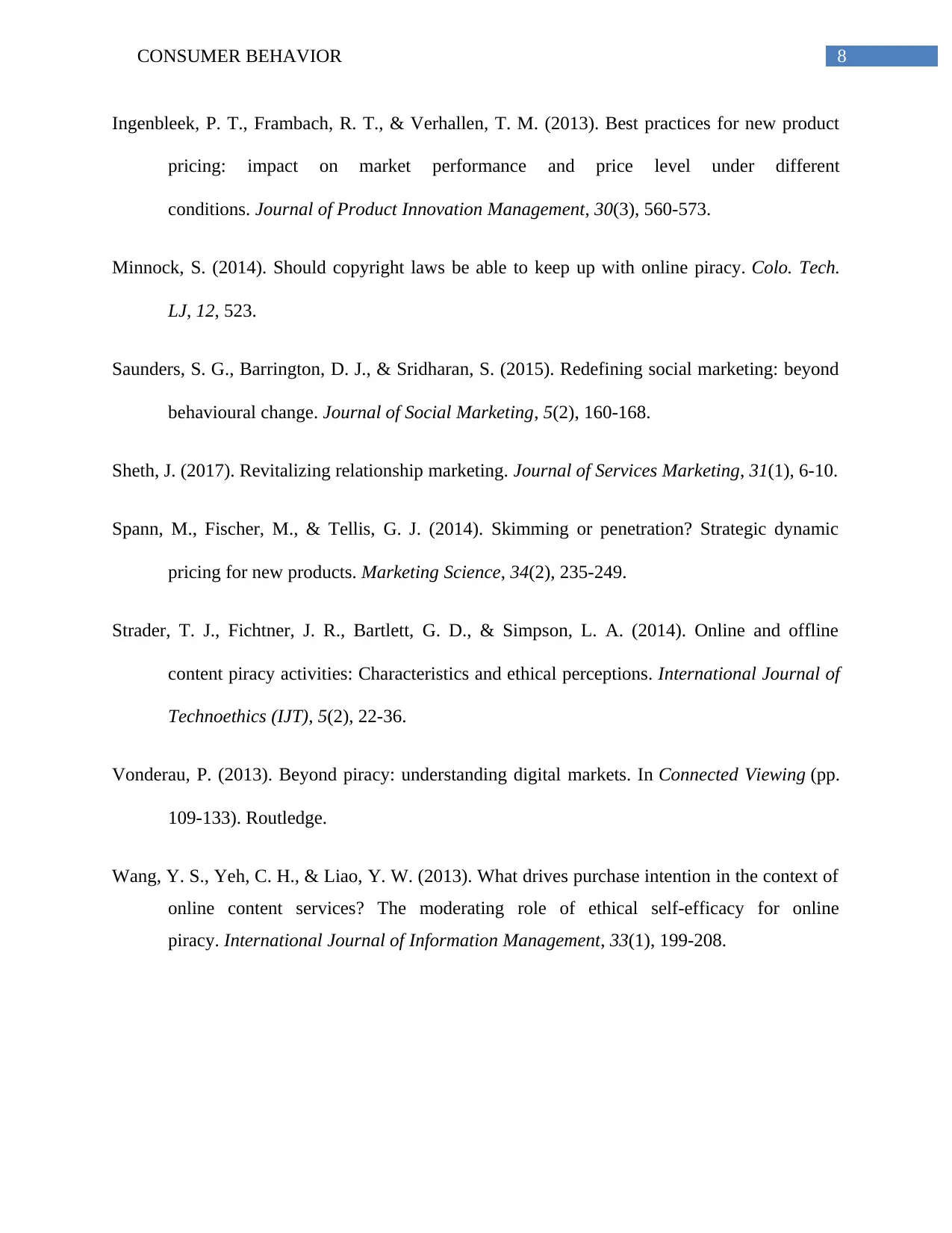
8CONSUMER BEHAVIOR
Ingenbleek, P. T., Frambach, R. T., & Verhallen, T. M. (2013). Best practices for new product
pricing: impact on market performance and price level under different
conditions. Journal of Product Innovation Management, 30(3), 560-573.
Minnock, S. (2014). Should copyright laws be able to keep up with online piracy. Colo. Tech.
LJ, 12, 523.
Saunders, S. G., Barrington, D. J., & Sridharan, S. (2015). Redefining social marketing: beyond
behavioural change. Journal of Social Marketing, 5(2), 160-168.
Sheth, J. (2017). Revitalizing relationship marketing. Journal of Services Marketing, 31(1), 6-10.
Spann, M., Fischer, M., & Tellis, G. J. (2014). Skimming or penetration? Strategic dynamic
pricing for new products. Marketing Science, 34(2), 235-249.
Strader, T. J., Fichtner, J. R., Bartlett, G. D., & Simpson, L. A. (2014). Online and offline
content piracy activities: Characteristics and ethical perceptions. International Journal of
Technoethics (IJT), 5(2), 22-36.
Vonderau, P. (2013). Beyond piracy: understanding digital markets. In Connected Viewing (pp.
109-133). Routledge.
Wang, Y. S., Yeh, C. H., & Liao, Y. W. (2013). What drives purchase intention in the context of
online content services? The moderating role of ethical self-efficacy for online
piracy. International Journal of Information Management, 33(1), 199-208.
Ingenbleek, P. T., Frambach, R. T., & Verhallen, T. M. (2013). Best practices for new product
pricing: impact on market performance and price level under different
conditions. Journal of Product Innovation Management, 30(3), 560-573.
Minnock, S. (2014). Should copyright laws be able to keep up with online piracy. Colo. Tech.
LJ, 12, 523.
Saunders, S. G., Barrington, D. J., & Sridharan, S. (2015). Redefining social marketing: beyond
behavioural change. Journal of Social Marketing, 5(2), 160-168.
Sheth, J. (2017). Revitalizing relationship marketing. Journal of Services Marketing, 31(1), 6-10.
Spann, M., Fischer, M., & Tellis, G. J. (2014). Skimming or penetration? Strategic dynamic
pricing for new products. Marketing Science, 34(2), 235-249.
Strader, T. J., Fichtner, J. R., Bartlett, G. D., & Simpson, L. A. (2014). Online and offline
content piracy activities: Characteristics and ethical perceptions. International Journal of
Technoethics (IJT), 5(2), 22-36.
Vonderau, P. (2013). Beyond piracy: understanding digital markets. In Connected Viewing (pp.
109-133). Routledge.
Wang, Y. S., Yeh, C. H., & Liao, Y. W. (2013). What drives purchase intention in the context of
online content services? The moderating role of ethical self-efficacy for online
piracy. International Journal of Information Management, 33(1), 199-208.
⊘ This is a preview!⊘
Do you want full access?
Subscribe today to unlock all pages.

Trusted by 1+ million students worldwide
1 out of 9
Related Documents
Your All-in-One AI-Powered Toolkit for Academic Success.
+13062052269
info@desklib.com
Available 24*7 on WhatsApp / Email
![[object Object]](/_next/static/media/star-bottom.7253800d.svg)
Unlock your academic potential
Copyright © 2020–2025 A2Z Services. All Rights Reserved. Developed and managed by ZUCOL.





